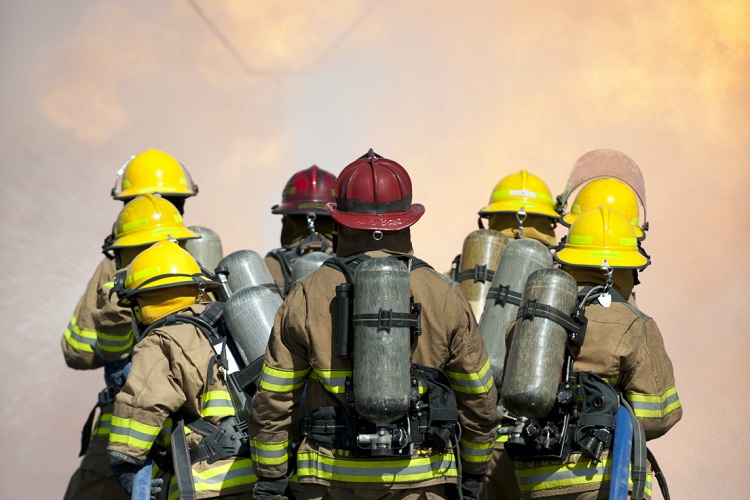

Photos courtesy of PSTrax.com.
By David Cain
In my early days as a young firefighter, not much was known about the relationship of toxic fire gases and the effect it had on our bodies. In fact, our bunker pants and boots sat right next to us in our bunk rooms. Today, it has all changed, and for the better. I cannot remember when and why it began to change, but today, that practice is long gone. Something happened over time, and the fire service began to make many changes regarding our health. Day boots were gone, Nomex® hoods were mandatory, and everyone had their own air packs. All this was a step in the right direction, but it was just the beginning.
The general notion that firefighters are fighting less structure fires these days may be true. However, per National Fire Incident Reporting System (NFIRS) data, there is a house fire every 86 seconds in America. In addition to house fires, firefighters must deal with many other types of fires, including vehicle, wildland, dumpster, and commercial and industrial. The fact remains that firefighters respond to many unknown situations that pose a risk to their life and of those who need their help.
The fire service has come a long way in providing superior personal protective equipment (PPE) and self-contained breathing apparatus protection. And yet the cancer rate of firefighters is around 63 percent based on recent data. Why is this?
RELATED: Sheridan on The Odor of Smoke ‖ Hall and Schnepp on Cyanide: Fire Smoke’s Other “Toxic Twin” ‖ Cline on Toxic Atmospheres
To understand any cause and effect, first understand the conditions of the cause. I asked myself, can we kill this “toxic snake”? So, I began my research. My source of information includes studies done at the National Institute of Standards and Technology (NIST), the National Fire Protection Association, the National Fallen Firefighters Foundation (NFFF), and other articles written in various fire journals.
The relationship of cancer and toxic gases is very strong; presumptive cancer laws are now recognizing this relationship. What are these gases, and can we identify their toxicity? We know that carbon monoxide (CO) accounts for 50 percent of the off gas in a fire. Beyond that, the list is very long and based on what is burning. A list of possible deadly gases was compiled by NIST labs and includes CO, carbon dioxide (CO2), acetic acid, ammonia, hydrogen chloride, hydrogen bromide, nitric oxide, hydrogen sulfide, hydrogen fluoride, hydrogen cyanide, toluene, and phosgene.

The Firefighter Exposure Project study sums it up with the following comments:
- “The conditions and concentrations that create such a toxic environment vary according to the chemistry of the products burning, the size of the fire, and ventilation conditions of the fire.”
- “The type and quantity of smoke particles and gases generated depended on the chemistry and physical form of the materials being burned. Synthetic materials produced more smoke than natural materials.”
- “Multiple asphyxiates, irritants and carcinogenic materials were found in smoke during suppression and overhaul phases.”
- “Long-term repeated exposure may accelerate cardiovascular mortality and the initiation and or progression of atherosclerosis.”
The research has me convinced, but more is coming—comprehensive research is what is needed. The challenge of getting the facts is difficult. Why?
First, firefighters are exposed to a wide variety of hazards that are not well identified or quantified. Second, the long gestation or latency period for cancers are difficult to study. Third, firefighters do not live in a fire bubble; other outside factors must be considered. Previous work, lifestyle, and other duties assigned in the firehouse could contribute to the cancer link; no one knows for sure. However, the evidence is convincing to me. The toxic snake is invisible and lives in this environment of fire—all fire—including structure, wildland, dumpster, vehicle, and anything else that burns.
The toxic snake is in the air, on the ground, and in the water. The toxic snake can move through the air and contaminate our coats, pants, boots, gloves, masks, bottles, tools, hose, nozzles, radios, and so on. And now there is proof of contaminants that get under our PPE and attack our skin.
NFFF research points out the following:
- There is scientific evidence of the toxic atmosphere in which firefighters work.
- More than 60 percent of occupational line-of-duty deaths are because of cancer, according to the International Assocaition of Fire Fighters.
- We have opportunities to improve data collection (i.e., in women and minorities).
- There is a higher level of cancer risk for firefighters than for the general public.
- Firefighters have increased exposure at PPE interfaces (wrist, neck, waist, ankles).
- Further work is needed on a cancer registration program.
- The solution to combating the risks associated with exposure to toxins will be cultural and technical.
- Adversaries have been identified, and we need data-driven strategies to counter the opposition.
There is nothing more important to the fire service than the protection of all firefighters from the exposures to the toxic snake. I will address some immediate steps we can take now to minimize this horrible situation in my next article.
David Cain is deputy chief (Ret.) with the Boulder (CO) Fire Department, where he served for 34 years. He works as a consultant for PSTrax.com, a technology service that helps fire departments across the country automate their apparatus, equipment, and inventory checks.

